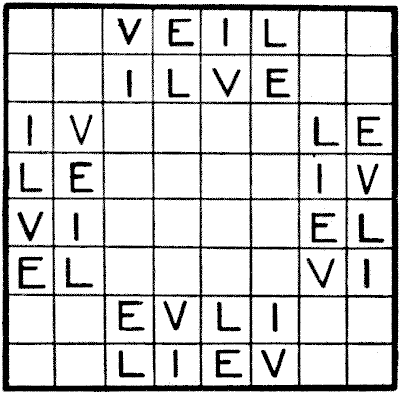
If the reader will examine the above diagram, he will see that I have so placed eight $V$'s, eight $E$'s, eight $I$'s, and eight $L$'s in the diagram that no letter is in line with a similar one horizontally, vertically, or diagonally. Thus, no $V$ is in line with another $V,$ no $E$ with another $E,$ and so on. There are a great many different ways of arranging the letters under this condition. The puzzle is to find an arrangement that produces the greatest possible number of four-letter words, reading upwards and downwards, backwards and forwards, or diagonally. All repetitions count as different words, and the five variations that may be used are: $V E I L,$ $V I L E,$ $L E V I,$ $L I V E,$ and $E V I L.$
This will be made perfectly clear when I say that the above arrangement scores eight, because the top and bottom row both give $V E I L;$ the second and seventh columns both give $V E I L;$ and the two diagonals, starting from the $L$ in the $5$th row and $E$ in the $8$th row, both give $L I V E$ and $E V I L.$ There are therefore eight different readings of the words in all.
This difficult word puzzle is given as an example of the use of chessboard analysis in solving such things. Only a person who is familiar with the Eight Queens problem could hope to solve it.
Solutions: 1
This eBook is for the use of anyone anywhere in the United States and most other parts of the world at no cost and with almost no restrictions whatsoever. You may copy it, give it away or re-use it under the terms of the Project Gutenberg License included with this edition or online at http://www.gutenberg.org. If you are not located in the United States, you'll have to check the laws of the country where you are located before using this ebook.